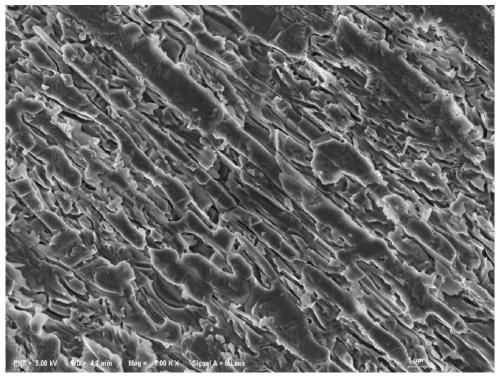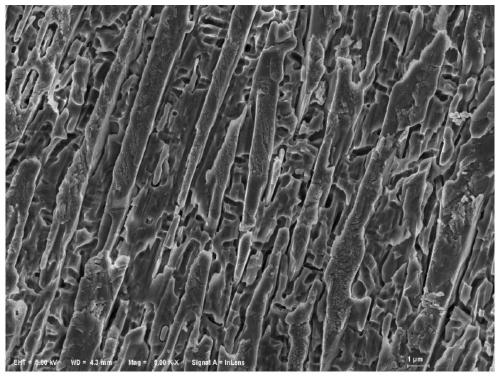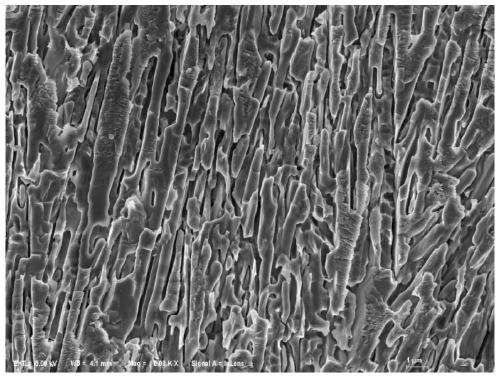A method for preparing glass-ceramics by using molten blast furnace slag
A technology of glass-ceramics and blast furnace slag, which is applied in the field of building decoration materials, can solve the problems of different types of crystal nucleating agents, different product performance and uses, etc., achieve short heat preservation time, realize the cycle of energy and economy, and reduce environmental pollution Effect
- Summary
- Abstract
- Description
- Claims
- Application Information
AI Technical Summary
Problems solved by technology
Method used
Image
Examples
Embodiment 1
[0027] A method for preparing glass-ceramics by using molten blast furnace slag specifically includes the following steps:
[0028] (1) Molten blast furnace slag is used as the main additive, the content is 48.7% of the total batch mass, and the auxiliary materials are 36.16% of quartz, 3.88% of alumina, 3.46% of magnesium oxide, 0.47% of manganese dioxide, and 0.25% of iron oxide. , 0.91% of titanium oxide, 1.45% of barium carbonate, 4.72% of sodium fluorosilicate, and a batch material for glass-ceramics; the chemical composition of blast furnace slag is calculated by mass percentage: SiO 2 36.77%, Al 2 O 3 14.45%, CaO 39.03%, MgO 7.84%, Fe 2 O 3 0.28%, TiO 2 0.79%, Na 2 O 0.24%, K 2 O 0.34%, MnO 0.16%, BaO 0.1%;
[0029] (2) Grind the batch material obtained in step (1) for 1 hour in a ball milling tank, fully uniform, put it into a corundum crucible, place in an electric furnace, and melt in an air atmosphere, and keep it at a temperature of 1350℃ for 4 hours to obtain a clari...
Embodiment 2
[0034] A method for preparing glass-ceramics by using molten blast furnace slag specifically includes the following steps:
[0035] (1) Molten blast furnace slag is used as the main additive, the content is 53.8% of the total batch mass, and the auxiliary materials are 32.39% of quartz, 3.15% of alumina, 4.89% of magnesium oxide, 0.46% of manganese dioxide, and 0.24% of iron oxide. , Titanium oxide 0.86%, Barium carbonate 1.45%, Sodium fluorosilicate 2.76%, mix with glass-ceramic batch materials; The chemical composition of blast furnace slag is calculated by mass percentage: SiO 2 35.78%, Al 2 O 3 14.94%, CaO 39.53%, MgO 7.84%, Fe 2 O 3 0.28%, TiO 2 0.79%, Na 2 O 0.24%, K 2 O 0.34%, MnO 0.16%, BaO 0.1%;
[0036] (2) Grind the batch material obtained in step (1) for 1.5h in a ball mill tank, fully uniform, put it into a corundum crucible, place it in an electric furnace, and melt it in an air atmosphere, and hold it at a temperature of 1400°C for 3h. Clear and uniform molten gla...
Embodiment 3
[0041] A method for preparing glass-ceramics by using molten blast furnace slag specifically includes the following steps:
[0042] (1) Molten blast furnace slag is used as the main additive, the content is 58.9% of the total batch mass, and the auxiliary materials are 28.6% of quartz, 2.41% of alumina, 2.13% of magnesium oxide, 0.46% of manganese dioxide, and 0.23% of iron oxide. , Titanium oxide 0.82%, Barium carbonate 1.44%, Sodium fluorosilicate 5.01%, the batch material for the configuration of glass-ceramic; The chemical composition of the blast furnace slag is calculated by mass percentage: SiO 2 36.28%, Al 2 O 3 14.94%, CaO 39.03%, MgO 7.84%, Fe 2 O 3 0.28%, TiO 2 0.79%, Na 2 O 0.24%, K 2 O 0.34%, MnO 0.16%, BaO 0.1%;
[0043] (2) Grind the batch material obtained in step (1) in a ball milling tank for 2 hours, fully uniform, put it into a corundum crucible, place in an electric furnace, and melt in an air atmosphere. The temperature is 1450℃ and the holding time is 2 hou...
PUM
| Property | Measurement | Unit |
|---|---|---|
| density | aaaaa | aaaaa |
| flexural strength | aaaaa | aaaaa |
| microhardness | aaaaa | aaaaa |
Abstract
Description
Claims
Application Information
 Login to View More
Login to View More - R&D
- Intellectual Property
- Life Sciences
- Materials
- Tech Scout
- Unparalleled Data Quality
- Higher Quality Content
- 60% Fewer Hallucinations
Browse by: Latest US Patents, China's latest patents, Technical Efficacy Thesaurus, Application Domain, Technology Topic, Popular Technical Reports.
© 2025 PatSnap. All rights reserved.Legal|Privacy policy|Modern Slavery Act Transparency Statement|Sitemap|About US| Contact US: help@patsnap.com



